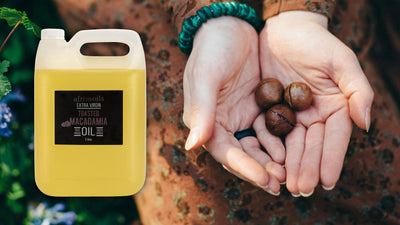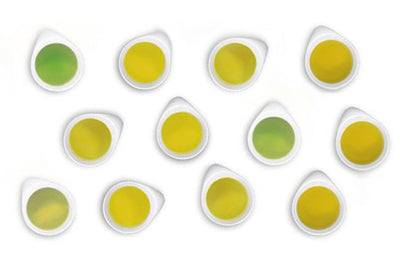Most of the extra virgin olive oil you’ll encounter at the grocery store) has undergone filtration. So, what’s the difference between filtered and unfiltered extra virgin olive oil? And is one really more flavourful or beneficial than the other?

To answer this question you first need to understand how EVOO is made.
Extra virgin olive oil all starts out being produced in the same way. First, the olives are picked, cleaned, and washed; then, the olives are ground producing a thick paste. The paste undergoes a slow stirring or kneading process called "malaxation" to start the separation of the oil from the solids and water. From there, this paste goes into a horizontal centrifuge (called a decanter) to separate the olive oil from the water and solids.
Next, the oil passes through a second higher speed centrifuge to remove most of the remaining water and particles. Exiting this vertical centrifuge is extra virgin olive oil—ready to use as "olio nuovo" ("new oil") if you so desire. This “olio nuovo” is an unfiltered olive oil, and it contains some remaining olive fruit particles and water suspended in the oil, which gives the oil a cloudy or hazy appearance.
But in many cases, the olive oil undergoes one more step of production: Filtration or racking, both of which separate the oil from any remaining olive fruit particles. In filtration, oil is put through filter media—most common are cellulose pads or diatomaceous earth—to trap any tiny particles of olive fruit and water that may still remain. In racking, the oil is allowed to rest in a series of large stainless steel drums to allow any final bits of water and sediment to settle out so the clean oil can be pumped to a fresh tank.
So, in a nutshell: Unfiltered olive oil contains residual olive fruit particles and/or moisture as a by - product of the extraction process, while filtered olive oil is free of particulates and fruit water. Below, we’ll dive into why some people prefer one type over the other, so you can make a more informed purchase.
To Filter...
Filtered EVOO is clear and will have no particles at the bottom of the bottle. Some people prefer filtered olive oil to cloudy unfiltered olive oil because they find its appearance more appealing.
Filtration is favoured by the majority of the world's best olive oil producers. Filtering right after milling quickly removes all the bioactive moisture that remains in the oil, resulting in better preservation of the positive fruity flavours of the oil. It is also possible to make a superb EVOO by careful racking after processing, but each year more producers choose to filter as a way to preserve the best quality.
Because filtered olive oil no longer contains olive fruit particles and residual moisture, it is more stable than unfiltered olive oil. The olive fruit particles that remain in unfiltered olive oil can actually start to ferment over time, contributing to off flavours. Typically, a high-quality filtered extra virgin olive oil is good for about 18-24 months after bottling, while an unfiltered olive oil should be consumed within 12 months (or less) of bottling.
In the case of an olio nuovo, which will have been deliberately bottled with a high level of particulates and moisture, the shelf life is closer to 4 months. That thick layer of sediment at the bottom of the bottom starts to ferment within a short time, so always enjoy your olio nuovo while it's very fresh. If it tends to take you a little while to get through a bottle of olive oil, filtered EVOO is the way to go.
Or Not to Filter
Unfiltered olive oil has not undergone filtration and has had only minimal racking (or in the case of olio nuovo, none at all). It contains some residual olive fruit particles and a bit of water suspended in the oil, which gives it a cloudy, somewhat opaque appearance.
Some people prefer unfiltered olive oil because they claim the remaining olive fruit particles result in a richer flavour and fruitier aroma. However, others assert that any difference in flavour would be minimal and that the difference disappears within a couple of months of processing (at which point the filtered oil will actually taste fruitier than the unfiltered because of the improved stability of the oil). So, deciding which variety is tastier may be somewhat subjective. The truth is, you can find flavourful unfiltered olive oils and flavourful filtered olive oils—and the “better tasting” oil will be a matter of personal preference.
Other people opt for unfiltered EVOO because it retains additional polyphenol compounds, which have health-promoting antioxidant properties. There are two main types of polyphenols: polar (dissolved in water) and non-polar (dissolved in fatty acids). So, the fact that unfiltered olive oil retains tiny amounts of water means that it retains both types of polyphenols, while filtered olive oil only retains non-polar polyphenols.
But the difference in overall polyphenol content between a filtered and unfiltered olive oil may not be that significant, and the increased biochemical activity in unfiltered oil may cancel any difference very quickly. Because so much more than filtration goes into determining an olive oil’s overall polyphenol levels—such as the types of olive used and when they were harvested—both filtered and unfiltered olive oils can be high in polyphenols. Bottom line: The main reason you’d choose an unfiltered EVOO is if you prefer the way it looks.
Filtered & Unfiltered Olive Oils Both Have Their Place
As you can see, filtered and unfiltered EVOO are pretty great and can have their place in your pantry—it's all a matter of personal preference. The main rule of thumb with olive oil is that as long as you’re opting for a high-quality extra virgin olive oil (emphasis on extra virgin!), then you’re going to end up with something that’s quite flavourful and nutrient-rich.
If you want the ultimate unfiltered experience, do yourself a favour and try a true olio nuovo—purchased within a month or two of the harvest—and use it up quickly so you can enjoy its flavours while they’re still vibrant and delicious. A great new unfiltered olive oil can really shine in raw applications such as in dipping oils, on beans or vegetables, and drizzled onto warm grain dishes or pasta.






